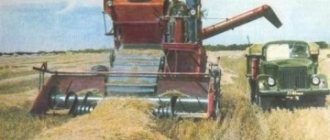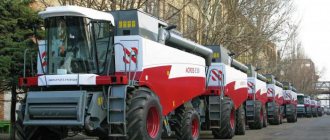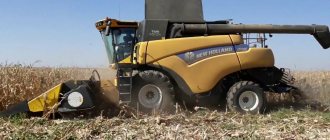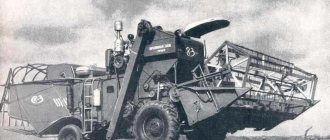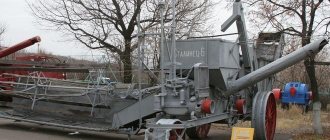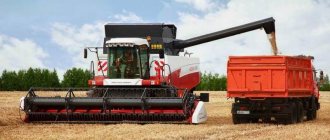Kolos SK 6 is a popular Soviet grain harvester manufactured by the Taganrog Combine Harvester Plant. The technique looks very impressive and resembles a huge ship with 2 large bunkers located on the sides.
The history of the model began in the 1970s. The development of the combine was carried out by a group of designers from the Taganrog plant under the leadership of engineer Izakson. The equipment was produced in several modifications. In 1971, the company began producing a version with 2 reels (SK 6-II). At the same time, in 1973, production of a single-drum version (SK 6) was opened, which lasted 6 years. The first modification lasted much longer - until 1984. The SK-6-II version, in addition to 2 drums, also received 2 augers with its own spiral. The equipment became the first Soviet combine harvester with a thresher 1500 mm wide. The model became widespread and was used everywhere. However, gradually interest in the combine began to fade.
Transmission of the SK-6 "Kolos" combine
The transmission of this combine includes a clutch, planetary gearboxes; main gear; differential; gear box.
The single-disc clutch is located on a receiving pulley connected to the variator using a V-belt. From the gearbox shaft, the motion energy is transferred to the main gear gear, and from it to the sprockets of the final drives, which are designed to drive the front wheels of the combine.
The power transmission consists of a single-disc clutch, three-speed gearbox, main gear, differential and onboard planetary gearboxes of the front drive axle.
The rear axle of the combine consists of a box-shaped beam with a hydraulic booster and swing arms. The combine's wheels are equipped with shoe brakes of a classic drum design.
SK-6 "Kolos" combines were equipped with automatic devices for regulating speed, depending on harvesting conditions.
Price
Production of Kolos SK 6 has ended. Currently, used versions of the combine are available for sale, but there are not many of them left. The cost of models in satisfactory condition (1980-1985) is 160-250 thousand rubles.
Main mistakes when purchasing Kolos SK 6:
- Depending on the generation, the equipment may have 1 or 2 threshing drums. This fact should be clarified prior to purchase;
- versions operated in Siberia are often equipped with an A-01M diesel unit (Altai Motor Plant). However, its power is not enough for normal operation;
- Some modifications of the combine are equipped with units from the Yaroslavl Motor Plant. This option will be optimal, since the YaMZ diesel engine shows higher technical characteristics.
Hydraulic system of the SK-6 "Kolos" combine
The hydraulics of the combine of this model consists of two parts.
The first is the main hydraulic device, which helps control the mounted units: the header (which mows cereals and coarse crops and at the same time forms a swath), a reel, and a chopper. The main hydraulic system operates from a hydraulic pump model NSh-32U.
The second part of the hydraulic system serves to facilitate the operator's steering of the combine. It also consists of a power steering system with an NSh-10 hydraulic pump. A hydraulic distributor is located on the side of the grain tank, which supplies oil from the NSh-10E (gear pump) to the system from a common tank.
Harvesters of different years of manufacture may have different hydraulic valve options: five-, six- or seven-section.
Hydraulic equipment performs the functions of regulating the frequency movements of the reeling device. Hydraulics also set the required height for the work process and the parameters for placing the reel on a horizontal plane.
The rotation speed of the drum mechanism for threshing harvested crops is regulated by changing the gear ratio for the V-belt speed supply to the drum. In the operator's cabin there are special levers with which the combine operator can control the distance between the concave bars and the drum whips.
Video
The history of the model began in 1958. Then the Rostselmash plant presented 27 of the latest SK 3 self-propelled combines, created from scratch (the numbers in the name had the following interpretation: SK - self-propelled combine, 3 - productivity, kg/sec). Previously, the company produced exclusively trailed versions, so the emergence of fundamentally new equipment was of great importance. In the winter of 1962, the SK 4 model with increased productivity was introduced. Another 11 years later, the premiere of the last representative of the family, the Niva SK 5 combine, took place. The equipment appeared as a result of a deep modernization of the previous version. Subsequently, the model was updated several times. Currently, the combine is sold under the name SK 5 Niva-Effect. The equipment now has a cabin with air conditioning, and green is used instead of the traditional red color. The popularity of the car remains high; it can still be found on Russian fields.
News here.
Important Basic malfunctions of refrigerators and how to repair them yourself
The main field of activity of the combine is the collection and primary processing of grain crops. Maneuverability and compact dimensions allow the equipment to work effectively in difficult terrain and narrow areas. The small turning radius makes the machine ideal for small areas. In cramped conditions, the Niva SK 5 simply has no equal.
Rostselmash also produces a special version designed for wet and weak-bearing soil. The modification is equipped with a half-track. Such changes make it possible to work in rice fields.
Together with special equipment, the combine can harvest corn. Improvements to the header provide the ability to work with soybeans, buckwheat and other cereal crops.
Niva SK 5 remains one of the most reliable and widespread combine harvesters in Russia.
Harvester working parts
The SK-6 Kolos combine harvester was equipped with headers with a working width from 3.2 meters to 7 meters. The width of the thresher is 1500 mm, and the diameter of the threshing drum is 600 mm; The straw walker at the combine is five-key.
The elevators are screw elevators; the total capacity of the two-section bunker is three cubic meters. The bunker was equipped with an automatic alarm and a vibration mechanism.
Specifications
Production characteristics of the combine harvester:
- Engine power SMD-64 - 150 hp. With.
- The crankshaft rotation speed is 1900 rpm.
- Fuel tank volume - 300 l.
- Operating speed - 7.4 km/h.
- Transport speed is 18.7 km/h.
- Thresher type: 1-beater.
- Number of whips - 8 pcs.
- The width of the threshing mechanism is 1500 mm.
- Drum diameter - 0.6 m.
- Length - 1.485 m.
- The working width of the header is 3.2-7 m.
- Bunker capacity - 3 m³.
- Dimensions - 10.92x5.3x3.92 m.
- Productivity - 8.5 t/h.
Advantages and disadvantages
Advantages of the Kolos combine:
- presence of a double bunker;
- comfortable working conditions;
- control over the harvesting process through installed alarms;
- large thresher sizes;
- availability of spare parts for repairs;
- reliability;
- endurance;
- high performance;
- low fuel consumption.
The main disadvantages include the complicated design of the machine and low engine power. The combine is designed in such a way that rear visibility is difficult and the operator has to work at random. Side visibility is hampered by the bunkers between which the cabin is located. There is not enough space above the engine for maintenance and repair, so special skills and professionalism are required when working with the machine. The unit is also not suitable for hilly surfaces.
Electrical equipment "Kolos"
The SK-6 Kolos combine harvester used a single-wire on-board electrical network, which provided an operating voltage of 12 Volts. The quality of engine starting, turning on and off of warning lamps, the operation of an alarm when damage occurred at key technical connecting nodes, and the level of control over technological operations of equipment depended on the normal functioning of electrical appliances. Sources of energy consuming devices are batteries and a generator.
Lighting elements – FG-304 headlights. Warning devices were available in the bunker compartment, in the storage area, and in grain and vegetable auger devices. Thanks to such a signaling system, it is possible to control the volume of loading of the storage bin, the closing (opening) and normal functioning of stackers, auger devices and straw walkers.
Special modifications of "Spike"
Some other modifications of this model were also made. In particular, the rice grain harvester SKPR-6 on a half-track – for working on waterlogged soils (from 1971 to 1979); SKG-6 is fully tracked; rice grain harvester SKGD-6 on a fully crawler track (from 1980 to 1984). Since 1985, a single-drum version of the combine has been produced - “Kolos” SK-6A.
Purpose
Ear SK 6 was used by agricultural enterprises. The machine was perfectly suited to the domestic climate and functioned effectively in various climatic zones. The combine was used to collect ripe cereal crops and showed a minimal level of losses. In addition to harvesting grain crops, the technique was used to work with legumes. The design features of the combine made it universal.
Production of Kolos SK 6 ended at the end of the 20th century, but certain modifications of the combine are still in use today. The second generation of the model is especially popular among consumers.
Operator's cabin and workplace
The cabin of the SK-6 Kolos combine is located in the central plane, equipped with sealing and sound insulation, a heating system and a fan. The seat is quite comfortable, adjustable according to the height and weight of the combine operator.
The controls, including instrumentation, brake and reel handles, and clutch levers, are in a convenient position. To control the speed of the reel drum, there is a tachometer in front of the driver. In case of malfunction of the grain bin, stacker, augers, elevators or straw walker, the corresponding light and sound signals are given in the cabin.
Combine harvester SK-6 "Kolos" at work
The ears rise in front of the reaper. In the process of movement, the reel bars tilt the stalks of the grain crops towards the header cut, where they are cut. Then a screw auger rakes the pile to the fingers, throws it onto an inclined conveyor and moves it to a four-bladed receiving beater. The drum hits the mass of ears with its beaters and knocks out the grains from the nests. The remaining part is removed and sent to the keyboard straw walker.
The air grill divides the bread mass into large and small fractions. The grain is cleaned, slides to the auger and rises to the hopper, powered by an unloader. Unthreshed spikelets with other impurities are fed by the spike elevator into the chute of the upper auger and enter the thresher for secondary threshing. The half filler pushes the mass into the front part of the stacker chamber, which is released while moving when the release pedal is pressed.

